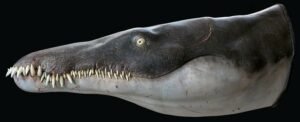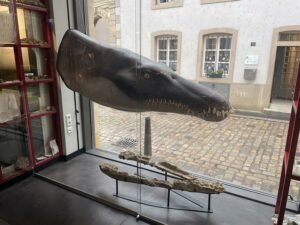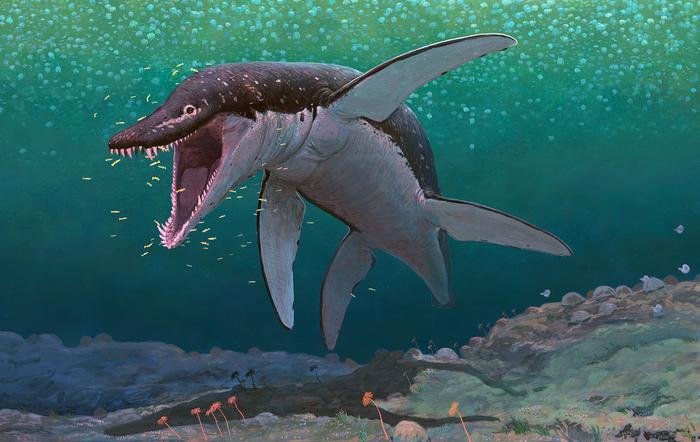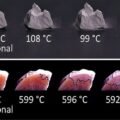The remains of an ancient sea monster that lived during the Age of the Dinosaurs have been classified as the oldest mega-predatory pliosaur ever. Relatives of the land-dwelling long-necked plesiosaurus, these ancient sea monsters were reptiles that roamed the ancient seas over 170 million years ago. The analysis and classification of such a rare fossilized specimen should help researchers shed more light on the life and evolution of these enigmatic ancient mega-predators.
Massive Ancient Sea Monster Had 5-Foot-Long Jawbone & Conical Teeth
Pliosaurs first appeared sometime around 200 million years ago. Having evolved from their ground-based relatives, these sea creatures (which have since been named Lorrainosaurus) were initially a tiny part of their ocean ecosystem. Then suddenly, they evolved massive jaws and teeth, turning them into what the researchers behind the new find described as an “enormous apex predator” in a relatively short period.
“Lorrainosaurus was one of the first truly huge pliosaurs,” explained Sven Sachs, a researcher at the Naturkunde-Museum Bielefeld in Germany, who led the study. “It gave rise to a dynasty of marine reptile mega-predators that ruled the oceans for around 80 million years.”
This particular ancient sea monster was actually found 40 years ago in France. Since then, it has undergone analyses by experts from Germany, Poland, Luxemburg, and Sweden, resulting in the new classification. According to the researchers, it was built as a highly efficient killing machine, leading them to dub it a “mega-predator.”


“It had jaws over 1.3 m long,” they explain, “with large conical teeth and a bulky ‘torpedo-shaped’ body propelled by four flipper-like limbs.” Combined with what the research team describes as “short necks and massive skulls” and an overall length of nearly 20 feet from “snout to tail,” this combination of mobility and power made Lorrainosaurus a formidable predator, allowing it to take advantage of the changing environment and ecosystem of the time and become a dominant force in the world’s ancient oceans.
Ancient Mega-Predator Equivalent to Today’s Killer Whales
Very little is known about these ancient sea monsters. However, finding a relatively intact fossil of Lorrainosaurus has helped researchers fill in many of the missing details, including their successful dominance over competitors like the ancient relatives of present-day marine crocodiles.
“Our identification of Lorrainosaurus as one of the earliest mega-predatory pliosaurs demonstrates that these creatures emerged immediately after a landmark restructuring of marine predator ecosystems across the Early-to-Middle Jurassic boundary, some 175 to 171 million years ago,” explained Daniel Madzia from the Institute of Paleobiology of the Polish Academy of Sciences, who co-led the study. “This event profoundly affected many marine reptile groups and brought mega-predatory pliosaurids to dominance over ‘fish-like’ ichthyosaurs, ancient marine crocodile relatives, and other large-bodied predatory plesiosaurs.”
Although this specimen is enormous, the researchers note that some ancient pliosaurs, like the Pliosaurus and Kronosaurus, were “absolutely enormous” and could grow to as much as 10 meters (about 33 feet) or more.
“They were ecological equivalents of today’s Killer whales and would have eaten a range of prey including squid-like cephalopods, large fish and other marine reptiles,” said senior co-author Benjamin Kear, Curator of Vertebrate Palaeontology and Researcher in Palaeontology at The Museum of Evolution, Uppsala University, who noted that remains of all of these have been found as “gut contents,” in previous pliosaur samples.


Ancient Sea Monster Findings Filling in the Blanks of Jurassic Era
With their findings published in the journal Scientific Reports, the researchers point out that although some initial testing of the remains occurred in 1983 and 1994, this is the first in-depth analysis resulting in an influx of invaluable data on these ancient mega predators.
“Lorrainosaurus indicates that the reign of gigantic mega-predatory pliosaurs must have commenced earlier than previously thought and was locally responsive to major ecological changes affecting marine environments covering what is now Western Europe during the early Middle Jurassic,” they write.
“Lorrainosaurus is thus a critical addition to our knowledge of ancient marine reptiles from a time in the Age of Dinosaurs that has as yet been incompletely understood,” added Benjamin Kear.
Christopher Plain is a Science Fiction and Fantasy novelist and Head Science Writer at The Debrief. Follow and connect with him on X, learn about his books at plainfiction.com, or email him directly at christopher@thedebrief.org.

